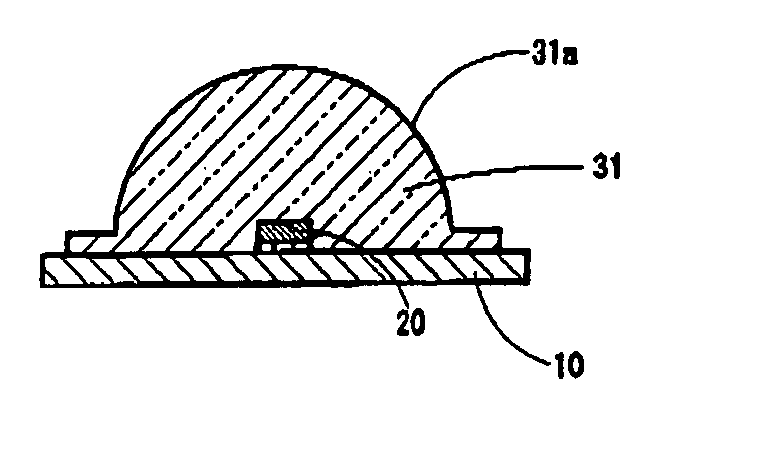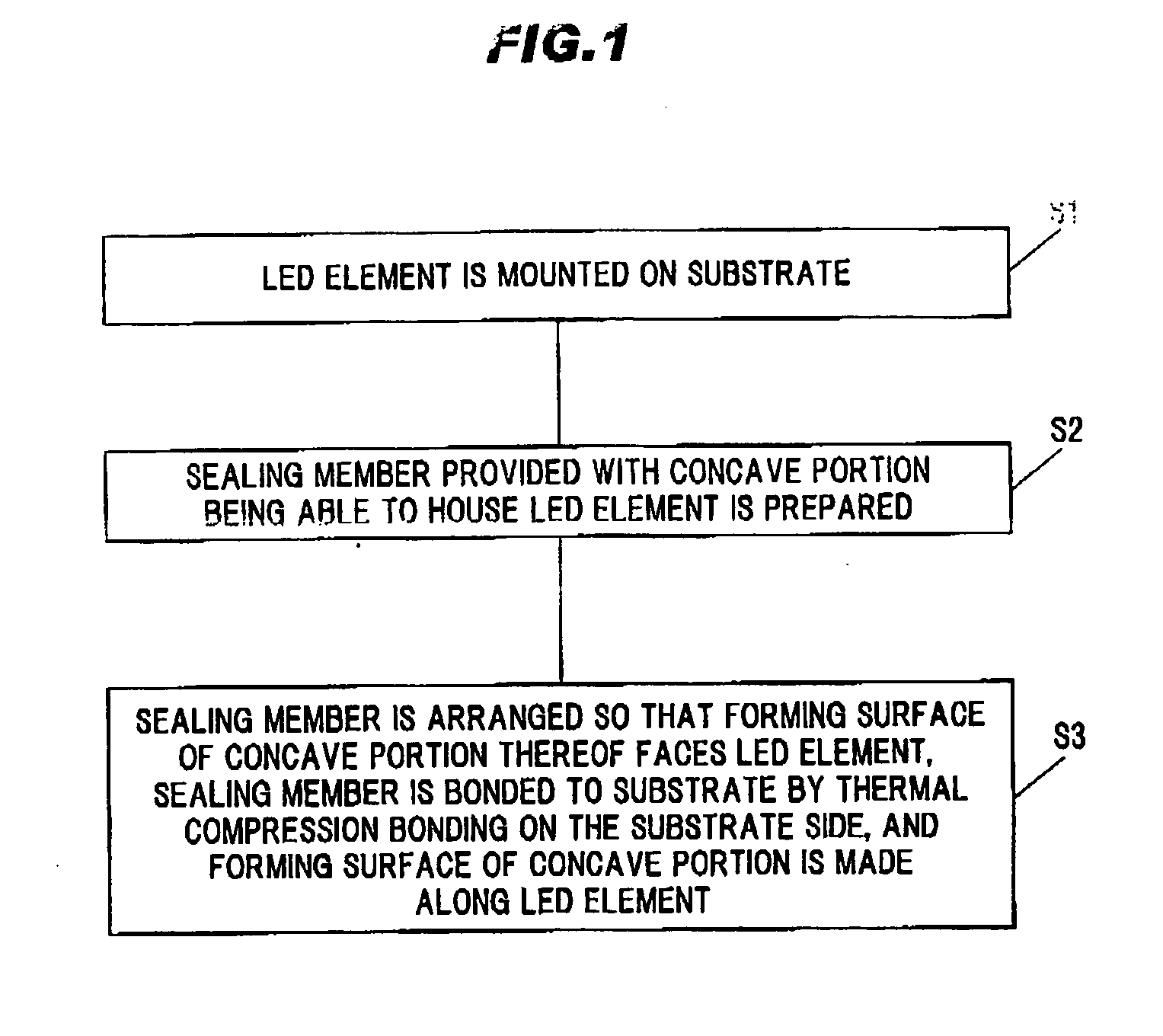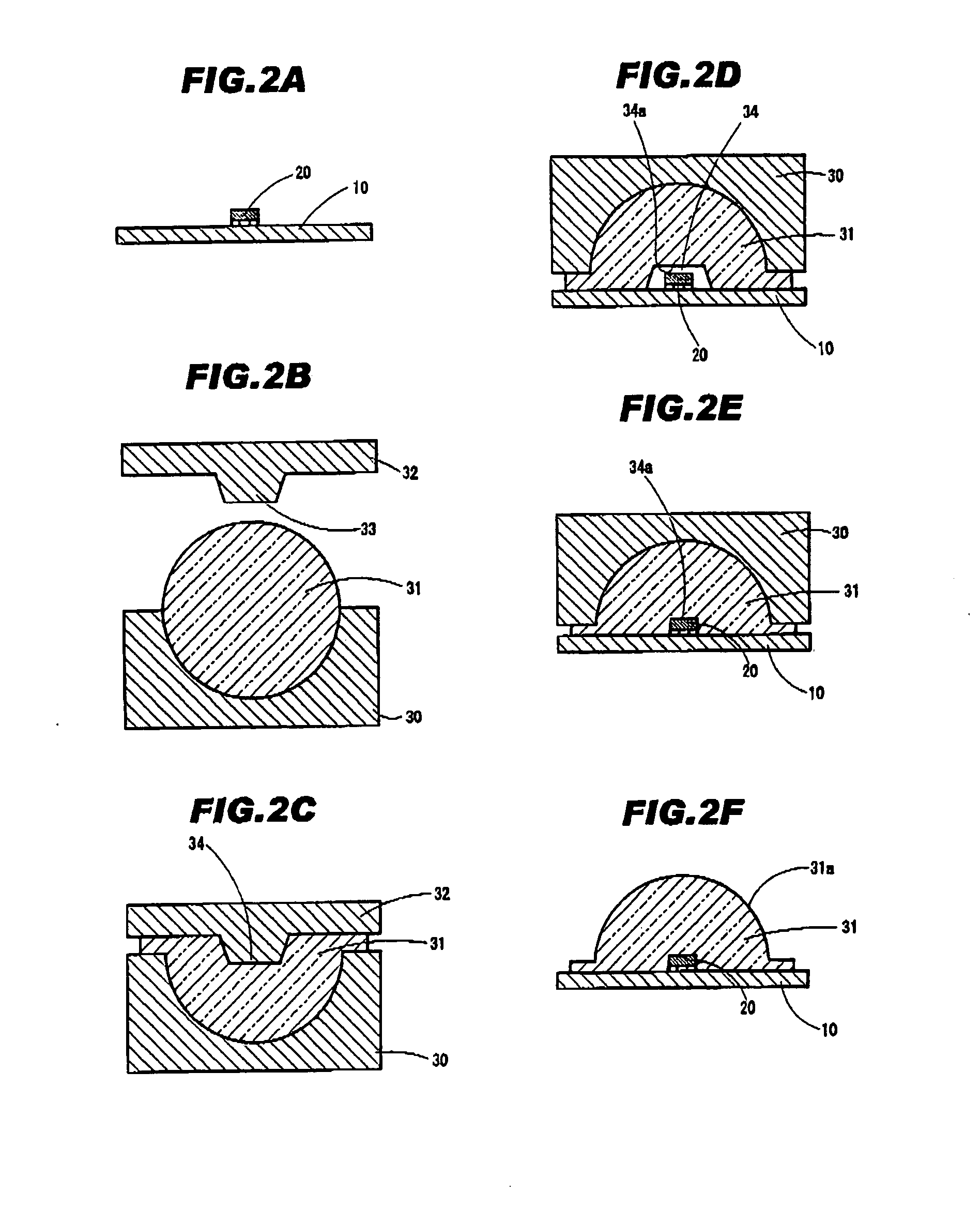Method of manufacturing led lamp
a manufacturing method and led lamp technology, applied in semiconductor/solid-state device manufacturing, electrical equipment, semiconductor devices, etc., can solve the problems of reduced light availability of led chips, uneven surface, and insufficient softening of sealing glass, so as to improve the surface accuracy of forming dies, prevent breakage or misalignment of led elements, and smooth sealing members.
- Summary
- Abstract
- Description
- Claims
- Application Information
AI Technical Summary
Benefits of technology
Problems solved by technology
Method used
Image
Examples
first embodiment
[0098]FIG. 1 is a flow diagram of a first embodiment. FIG. 2 is a schematic vertical cross sectional view for illustrating manufacturing processes in the first embodiment.
[0099]As shown in FIG. 1, a mounting process for flip-chip-mounting a LED element on a substrate (S1), a sealing member preparation process for preparing a sealing member provided with a concave portion capable of housing the LED element (S2), and a sealing process in which the sealing member is arranged so that a forming surface of the concave portion of the sealing member faces the LED element, the sealing member is bonded to the substrate by thermally compressing on the substrate side and the forming surface of the concave portion is made along the LED element (S3) are included.
[0100]As shown in FIG. 2(A), a LED element 20 is flip-chip-mounted on a substrate 10 in the mounting process (S1). The substrate 10 is a ceramic substrate. The LED element 20 is a flip-chip type LED element and generates white light. The ...
second embodiment
[0132]FIG. 6 is a schematic vertical cross sectional view for illustrating manufacturing processes in a second embodiment of the invention.
[0133]Firstly, as shown in FIG. 6(A), multiple LED elements 20 (sixteen in this example) are mounted on the substrate 11 by vertically and horizontally arranging in a square pattern at equal intervals. Next, a sealing member 311 is prepared. As shown in FIG. 6(B) which is a cross section taken on line A-A of FIG. 6(A), the sealing member 311 includes plural concave portions 341 having a trapezoidal vertical cross sectional shape at positions facing each of the LED elements 20.
[0134]The sealing member 311 is formed of the same material as the sealing member 31 and the concave portion 341 is formed in the same manner as the concave portion 34 of the sealing member 31.
[0135]Then, as shown in FIG. 6(C), the sealing member 311 is arranged on the substrate 11 so that the concave portion 341a of each concave portion 341 encloses the corresponding LED el...
third embodiment
[0139]FIG. 7 is a schematic vertical cross sectional view for illustrating manufacturing processes in a third embodiment.
[0140]The third embodiment is different from the second embodiment (see FIG. 6) in that, as shown in FIG. 7(A), (a) a sealing member 312 provided with a lens forming portion (main body) 312a having a concave portion 341 and a basal portion 312b connecting the adjacent lens forming portions (main bodies) 312a and bonded to the substrate 10 by pressure is used instead of the sealing member 311 and (b) an upper die (sealing member forming die) 301 provided with concave portions 301a along the lens forming portions (main bodies) 312a of the sealing member 312 is used instead of the upper die 300.
[0141]The sealing member 312 is formed of the same material as the sealing member 311.
[0142]Then, as shown in FIG. 7(B), the basal portion 312b of the a sealing member 321 is bonded to the substrate 11 by thermal compression by pressing down the upper die 301. After that, indi...
PUM
| Property | Measurement | Unit |
|---|---|---|
| temperature | aaaaa | aaaaa |
| Tg | aaaaa | aaaaa |
| Tg | aaaaa | aaaaa |
Abstract
Description
Claims
Application Information
 Login to View More
Login to View More - R&D
- Intellectual Property
- Life Sciences
- Materials
- Tech Scout
- Unparalleled Data Quality
- Higher Quality Content
- 60% Fewer Hallucinations
Browse by: Latest US Patents, China's latest patents, Technical Efficacy Thesaurus, Application Domain, Technology Topic, Popular Technical Reports.
© 2025 PatSnap. All rights reserved.Legal|Privacy policy|Modern Slavery Act Transparency Statement|Sitemap|About US| Contact US: help@patsnap.com



